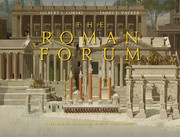Book contents
- Frontmatter
- Map
- Contents
- Preface
- Acknowledgments
- Part I. Architecture in the Roman Forum during the Empire: A Brief History
- Part II. The Monuments
- 3 The Temple of Antoninus and Faustina
- 4 The Temple of Caesar (Aedes divi Iuli)
- 5 The Basilica Æmilia
- 6 The Curia
- 7 The Arch of Septimius Severus
- 8 Minor Monuments
- 9 The Temple of Concord
- 10 The Temple of Vespasian
- 11 The Tabularium
- 12 The Portico of the Dei Consentes
- 13 The Temple of Saturn
- 14 The Basilica Julia
- 15 The Arch of Tiberius
- 16 The Schola Xanthi
- 17 The Diocletianic Honorary Columns
- 18 The Temple of Castor and Pollux
- 19 The Parthian Arch of Augustus (19 BCE)
- 20 The Temple of Vesta
- Part III. Conclusions
- Glossary
- Notes
- Bibliography
- Sources for Coin Images from the Internet and for Other Images
- Index
12 - The Portico of the Dei Consentes
from Part II. - The Monuments
Published online by Cambridge University Press: 05 March 2015
- Frontmatter
- Map
- Contents
- Preface
- Acknowledgments
- Part I. Architecture in the Roman Forum during the Empire: A Brief History
- Part II. The Monuments
- 3 The Temple of Antoninus and Faustina
- 4 The Temple of Caesar (Aedes divi Iuli)
- 5 The Basilica Æmilia
- 6 The Curia
- 7 The Arch of Septimius Severus
- 8 Minor Monuments
- 9 The Temple of Concord
- 10 The Temple of Vespasian
- 11 The Tabularium
- 12 The Portico of the Dei Consentes
- 13 The Temple of Saturn
- 14 The Basilica Julia
- 15 The Arch of Tiberius
- 16 The Schola Xanthi
- 17 The Diocletianic Honorary Columns
- 18 The Temple of Castor and Pollux
- 19 The Parthian Arch of Augustus (19 BCE)
- 20 The Temple of Vesta
- Part III. Conclusions
- Glossary
- Notes
- Bibliography
- Sources for Coin Images from the Internet and for Other Images
- Index
Summary
The Republic
Located on the Clivus Capitolinus (Figs. 0.1, 4, 12.1–13), the Portico of the Dei Consentes perpetuated the name of a Greek cult introduced into Rome during the the late third century BCE while the Romans were fighting the Second Punic War. In 217, with a beachhead in Italy, Hannibal had just defeated the Romans at Lake Trasimene some 141 km northeast of Rome. The Roman commander, the consul, Gaius Flaminius, had been killed. Fifteen thousand Romans died with him, and ten thousand fled. To calm Rome’s terrified citizens, the Senate gave command of the war against Hannibal to the distinguished conservative, Quintus Fabius Maximus, naming him dictator and propitiating the gods:
A lectisternium (a sacred banquet with special sacrifices) was…celebrated during three days.… Six couches were displayed: one for Jupiter and Juno, a second for Neptune and Minerva, a third for Mars and Venus, a fourth for Apollo and Diana, a fifth for Vulcan and Vesta, a sixth for Mercury and Ceres.
This was the first appearance in Rome of the Olympian deities who formed an advisory council for Jupiter, the “Dei Consentes,”
those twelve gods who are included by Ennius, with a metrical arrangement of their names in two verses:Juno, Vesta, Minerva, Ceres, Diana, Venus, Mars,
Mercurius, Jovi [sic], Neptunus, Vulcanus, Apollo
“Urban gods whose gilded images stand in the Forum, six males, six females.”
- Type
- Chapter
- Information
- The Roman ForumA Reconstruction and Architectural Guide, pp. 210 - 224Publisher: Cambridge University PressPrint publication year: 2015

